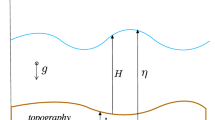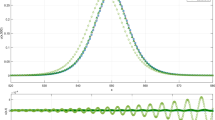Abstract
We present a new numerical technique to approximate solutions to unsteady free surface flows modelled by the two-dimensional shallow water equations. The method we propose in this paper consists of an Eulerian–Lagrangian splitting of the equations along the characteristic curves. The Lagrangian stage of the splitting is treated by a non-oscillatory modified method of characteristics, while the Eulerian stage is approximated by an implicit time integration scheme using finite element method for spatial discretization. The combined two stages lead to a Lagrange–Galerkin method which is robust, second order accurate, and simple to implement for problems on complex geometry. Numerical results are shown for several test problems with different ranges of difficulty.
Similar content being viewed by others
References
Allievi A., Bermejo R. (1997): A generalized particle search-locate algorithm for arbitrary grids. J. Comp. Phys. 132, 157–166
Augenbaum J. (1984): A Lagrangian method for shallow water equations based on voronoi mesh: one dimensional results. J. Comp. Phys. 53, 240–265
Bermejo R. (1995): A Galerkin-characteristic algorithm for transport-diffusion equations. SIAM J. Numer. Anal. 32, 425–454
Bermejo R. (2001): Analysis of a class of quasi-monotone and conservative semi-Lagrangian advection schemes. Numer. Math. 87, 579–623
Bermejo R., El-Amrani M. (2003): A finite element semi- Lagrangian explicit Runge–Kutta–Chebyshev method for convection dominated reaction-diffusion problems. J. Comp. Appl. Math. 154, 27–61
Bermejo R., Staniforth A. (1992): The conversion of semi- Lagrangian advection schemes to quasi-monotone schemes. Mon. Weather. Rev. 120, 2622–2632
Brooks A., Hughes T. (1982): Stream-line formulation for convection dominated flows with particular emphasis on the incompressible Navier–Stokes equations. Comp. Meth. Appl. Mech. Eng. 32, 199–259
Chen J., Lobo N., Hughes C., Moshell J. (1997): Real-time fluid simulation in a dynamic virtual environment. IEEE Comput. Graph. 17, 52–61
Dawson C., Proft J. (2004): Coupled discontinuous and continuous Galerkin finite element methods for the depth-integrated shallow water equations. Comp. Methods Appl. Mech. Eng. 193, 289–318
Donea J. (1984) : A Taylor–Galerkin method for convective transport problems. Int. J. Numer. Meth. Eng. 20, 101–119
Douglas J., Russell T. (1982): Numerical methods for convection dominated diffusion problems based on combining the method of characteristics with finite elements or finite differences. SIAM J. Numer. Anal. 19, 871–885
Douglas J., Huang C., Pereira F. (1999): The modified method of characteristics with adjusted advection. Numer. Math. 83, 353–369
Durran D. (1998): Numerical Method for Wave Equations for Geophysical Fluid Mechanics. Springer, Berlin Heidelberg New York
Foster N., Metaxas D. (1996): Realistic animation of liquids. Graph. Models Image Proc. 58, 3471–483
Gill A. (1982): Atmosphere-Ocean Dynamics. Academic, New York
Giraldo F. (1998): The Lagrange–Galerkin spectral element method on unstructured quadrilateral grids. J. Comp. Phys. 147, 114–146
Griebel M., Dornseifer T. (1995): Numerische Simulation in der Strömungsmechanik. Vieweg, Braunschweig
Haidvogel D., Beckman A. (1999): Numerical Ocean Circulation Modeling. Imperial College Press, London
Hudson, J.: numerical techniques for morphodynamic modelling. Ph.D. Thesis, University of Reading, Department of Mathematics (2001)
Hughes T., Franca I., Hulbert G. (1989): A new finite element formulation for computational fluid dynamics: VIII. The Galerkin/Least-Squares method for advective-diffusive equations. Comp. Meth. Appl. Mech. Eng. 73, 173–189
Johnson K. (1997): A Moderns Introduction to the Mathematical Theory of Water Waves. Cambridge University Press, Cambridge
Kaazempur-Mofrad M., Ethier C. (2002): An efficient characteristic Galerkin scheme for the advection equation in 3D. Comp. Methods App. Mech. Eng. 191, 5345–5363
Lohner R., Morgan K., Zienkiewicz O. (1984): The solution of non-linear hyperbolic equation systems by finite element method. Int. J. Numer. Meth. Fluids 4, 1043–1063
Morton K. (1996): Numerical Solution of Convection-Diffusion Problems. Chapman & Hall, London
Nazarov A. (1991): Mathematical modeling of a snow-powder avalanche in the frame work of the equations of two-layer shallow water. Fluid Dyn. 26, 70–75
Peachey D. (1986): Modeling waves and surfaces. Comput. Graph 20, 65–74
Pedlosky J. (1987): Geophysical Fluid Dynamics. Springer, Berlin Heidelberg New York
Pironneau O. (1982): On the transport-diffusion algorithm and its applications to the Navier–Stokes equations. Numer. Math. 38, 309–332
Pudykiewicz J., Staniforth A. (1984): Some properties and comparative performance of the semi-Lagrangian method of robert in the solution of advection-diffusion equation. Atmos. Ocean 22, 283–308
Rebollo T., Domínquez A., Fernández E. (2003): A family of stable numerical solvers for the shallow water equations with source terms. Comp. Methods Appl. Mech. Eng. 192, 203–225
Seaïd M.(2002): On the quasi-monotone modified method of characteristics for transport-diffusion problems with reactive sources. J. Comp. Methods Appl. Math. 2, 186–210
Seaïd M.(2002): Semi-Lagrangian integration schemes for viscous incompressible flows. J. Comp. Methods Appl. Math. 4, 392–409
Simo J., Armero F. (1994): Unconditional stability and long-term behavior of transient algorithms for the incompressible Navier–Stokes and Euler equations. Comp. Methods Appl. Mech. Eng. 111, 111–154
Smith A., Silvester D. (1997): Implicit algorithms and their linearisation for the transient Navier–Stokes equations. IMA J. Numer. Anal. 17, 527–543
Staniforth A., Coté J. (1991): Semi-Lagrangian integration schemes for the atmospheric models: a review. Wea. Rev. 119, 2206–2223
Stoker J. (1957): Water Waves: The Mathematical Theory with Applications. Interscience, New York
Süli E. (1988): Convergence and stability of the Lagrange–Galerkin method for the Navier–Stokes equations. Numer. Math. 53, 459–483
Temperton C., Staniforth A. (1987): An efficient two-time-level Semi-Lagrangian semi-implicit integration scheme. Qt. J. Ry. Meteorol. Soc. 113, 1025–1039
Thomas S., Malevsky A., esgagné M., Pellerin P. (1997): Massively parallel implementation of the mesoscale compressible community model. Parallel Comput. 23, 2143–2160
Toro E. (2001): Shock-capturing methods for Free-Surface Shallow Flows. Wiley, New York
Townson J. (1991: Free-surface Hydraulics. Unwin Hyman, London)
Van der Vorst H. (1992): BI-CGSTAB: a fast and smoothly converging variant of BI-CG for the solution of nonsysmmetric linear systems. SIAM J. Sci. Stat. Comp. 13, 631–644
Wang Z., Shen H. (1999): Lagrangian simulation of one-dimensional dam-break flow. J. Hydraul. Eng. 125, 1217–1220
Zalesak S. (1979): Fully Multidimensional flux-corrected transport algorithms for fluids. J. Comp. Phys. 31, 335–362
Zhao D., Shen H., Tabios G., Lai J., Tan W. (1994): Finite- volume two-dimensional unsteady-flow model for river basins. J. Hydraul. Eng. 120, 863–883
Zienkiewicz O., Ortiz P. (1995): A split-characteristic based finite element model for the shallow water equations. Int. J. Numer. Meth. Fluids 20, 1061–1080
Author information
Authors and Affiliations
Corresponding author
Additional information
Communicated by G.Wittum
Rights and permissions
About this article
Cite this article
Seaïd, M., El-Amrani, M. Lagrange–Galerkin method for unsteady free surface water waves. Comput. Visual Sci. 9, 209–228 (2006). https://doi.org/10.1007/s00791-006-0027-8
Received:
Accepted:
Published:
Issue Date:
DOI: https://doi.org/10.1007/s00791-006-0027-8




